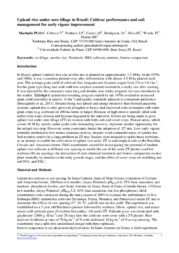Upland rice under zero tillage in Brazil: Cultivar performance and soil management for early vigour improvement.
Upland rice under zero tillage in Brazil: Cultivar performance and soil management for early vigour improvement.
Author(s): MACHADO, P. L. O. A.; COBUCCI, T.; PACHECO, L. P.; CASTRO, A. P.; BARRIGOSSI, J. A.; SILVA, J. G.; WRUCK, F. J.; MADARI, B. E.
Summary: In Brazil, upland (rainfed) rice aka aerobic rice is planted on approximately 1.5 M ha. In the 1970s and 1980s, it was a common pioneer crop after deforestation with almost 4.5 M ha planted each year. The average grain yield of cultivars like Araguaia and Guarani ranged from 2.0 to 3.0 t ha-1, but the grain type (long and wide with low amylose content) resulted in a sticky rice after cooking. It was rejected by the consumers once long and slender, non-sticky irrigated rice was introduced in the market. Studies were initiated to tackle those problems, as an attempt to enable the cultivation of upland rice under ZT in acid tropical soils in the Brazilian Cerrado and Amazonia biome. Field experiments started for investigating the potential of modern upland rice cultivars at different row spacing to enable the use of the same ZT planter used for soybean (40-cm spacing), the interaction of seed chemical treatment and furrow compaction on rice plant mortality by termites in the early growth stages, and the effect of cover crops on mulching and soil NO3- and NH4+. Material and Methods
Publication year: 2011
Types of publication: Paper in annals and proceedings
Unit: Embrapa Rice & Beans
Keywords: Aerobic rice, Arroz, Cultivars, Furrow compaction, Isoptera, No-tillage, Oryza sativa, Plantio direto, Rice, Variedade
Observation
Some of Embrapa's publications are published as ePub files. To read them, use or download one of the following free software options to your computer or mobile device. Android: Google Play Books; IOS: iBooks; Windows and Linux: Calibre.
Access other publications
Access the Agricultural Research Database (BDPA) to consult Embrapa's full library collection and records.
Visit Embrapa Bookstore to purchase books and other publications sold by Embrapa.

